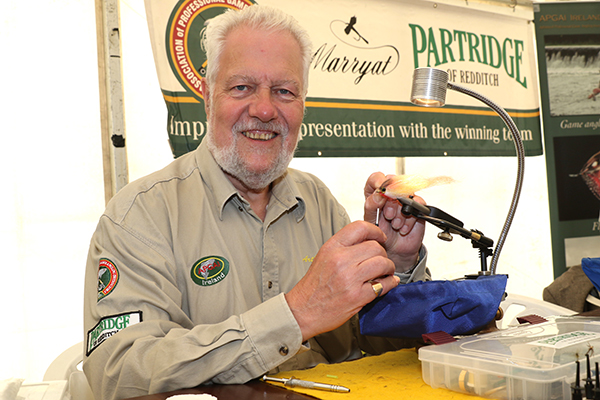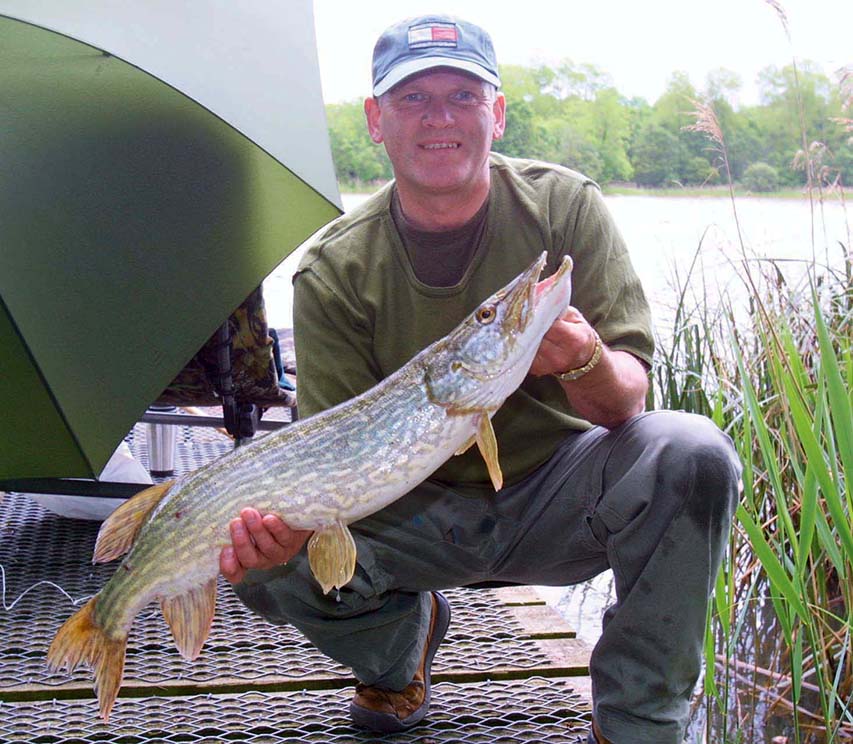A look at a tackle, methods and baits for fishing for pike.
You may have fished for mackerel, flounders, trout or smaller species, but pike fishing is not for the faint hearted. It is a battle – you and the pike – and you don’t always win! writes Jim Masson.
A very large pike can weigh over forty pounds and while we would all like to hook up and land one of these rare beauties, that is a lifetime experience few of us experience.
I’ll basically describe tackle that would be suitable for average sized fish from jack pike to decent catches up to 20lbs. Angling for the big specimens requires more specialist tackle… but then, with pike fishing, you just never know what will take your bait !
At the moment all inland fisheries are closed due to coronavirus, so this article will be a first step in planning for the future foray into pike angling in the months ahead once the coronavirus lockdown eases.
So, you are interested in fishing for pike? What is the best way to get involved? I would first of all take a walk along the banks where pike anglers habit and and chat to them and get a feel for this part of the sport.

You will learn a lot about local factors eg about best baits and the strength of the stock etc. But a word of caution. Most anglers go fishing to get away from people so don’t overstay your welcome on the bank or river.
Getting Started: Now, assuming you have your course or game licence, and your permit if that applies, let’s begin at the start. You could join an angling club and the members will no doubt be very welcoming and help you through the early steps.
They will probably even fish beside you to help you tackle up, bait up correctly and find you early catches.
But not everyone enjoys clubs and the whole idea of angling is to get away and chill out. You will need to know which waters hold a head of pike. Generally, fast flowing rivers and streams don’t hold pike.
Pike prefer slower, deeper waters such as loughs, lakes, canals, and even big ponds, but there are some whoppers in the Erne river system in Fermanagh.
Check out Inland Fisheries and the Loughs Agencies websites for further information and locations of various fisheries. And do an internet trawl and look at You Tube instruction videos too. Angling magazines also can be very helpful.

Once you have done all this preparatory research and understand what this niche interest is about, you will be ready to go solo on the bank.
Tackle: a carbon pike rod, approximately 10-11 feet long is ideal. You don’t want it too stiff or too flexible. It has to cast often a four ounce weight, a float, and bait. You will then need a decent sized fixed spool reel backed up by 15lb breaking strain (BS) nylon monofilament line to begin with. Y
ou will if fishing near the surface need a range of floats to hold up your bait. Also, a range of weights up to 4oz to allow you to cast out a distance and also hold in a current if you are bottom ledgering.
Smaller items such as barrel swivels, small elastic bands and small split shot are also useful. And rubber piping to put a small section onto your line protects the weight from damaging the knots at the swivel.
You will also need hook traces with two sets of treble hooks. Use barbless ones, and if they are barbed pinch them down with your pliers.
This protects you and the pike, especially if the pike is deep hooked, or if you get yourself hooked. Your tackle shop will advise you on the hook sizes. you will need double treble hooks on wire traces as these will not break as a rule with the pike’s teeth cutting through as they would with just a nylon to hook scenario.
Angling Methods. Float fishing is popular. Or ledgering. And you can spin for them too and if you really want to fly your kite, you could fly fish for pike but that is a specialised form and you’s best get the hang of handling pike first before you venture into this technique.
Bait fishing is probably the most common method of angling for pike, and live baiting is prohibited on many waters. My most favourite deadbait is mackerel tails. But you can use smelts, eel, and other baits available at your local tackle shop or fish market.
If you are course fishing and small fish die in your keep net, you could use those eg rudd, roach. You could also fish with live leeches but that again is a more specialist procedure.
Just hook your bait onto both sets of hooks making sure it is secure. I like to have the hook pointing away from the main line as the pike will likely swallow it head first. Use a small rubber band if it looks as though it could fall off.
You will have to learn how to balance your float and bait. You may need to put a small weight eg spit shot on you bait line between bait and float to ensure the bait stays down in any current and wind. And your may have to slide your float up and down until you think you have found the right fishing depth.
Small rubber bands or a tiny split shot on the line can act as a stop preventing the float sliding down to the trace.
You are almost ready to cast now into the mystery of the deep for one of those elusive toothy monsters. A nice fish to start with would be a 5lb pike.

A 10-pounder will get your adrenaline going as it more of a handful, a 15-pounder will test you, and a twenty pounder may turn you into a nervous wreck and into a beaming babbler after you land and weigh it.
Ledger fishing. The simplest system is to slide a weight onto your main line then attach at small piece of rubber tubbing to protect your knot, then attacked the end to a swivel eg a four ounce weight. The weight can slide up and down your main line.
Then at the business end, add your wire trace with its double treble hooks (barbless). When the pike picks up the bait the line rune through the swivel as the pike moves off then the line tightens and you feel the tugs.
That’s when you set the hooks (not too violently as it could damage the pike) making sure your line tension on the rachet is set right. Keep your rod well up allowing it to bend and tire out the fish. If it is a sizeable one, it may peel out some line. Just let it run and then try and pump it back again.
Pumping action means you lift your rod up a few feet and lower it reeling in some lime and repeating this. A big fish will give you a sore arm by the time the fight is over or if you net or beach it.
Other more advanced methods, the most simple of which is casting with spinners, spoons, plugs, imitation creatures, also include spinning with a deadbait eg a fish working it through the water; and fly fishing for pike which is a completely different art form.
Suggested General List Of Equipment. Right, so you want to do this right! You will need a couple of rod rests, a sizeable landing net; a landing mat; unhooking equipment such as short nose and long nosed pliers; disgorger; wire snips in case you have to remove a trace if the fish is deep hooked; and a set of weighting scales; small scissors.
You will also need a collapsable seat. Some spare nylon life is useful. And of course, if you are fishing in inclement weather, you will need to be well wrapped up and protected from the elements. Lastly, you will need a sizeable rucksack or holdall to carry your gear.
A flask of tea or coffee is certainly another useful item. You could get a safety glove which will allow you to ‘chin’ the fish out of he water safely (ie lift it from below the lower jaw putting your finger below the gills and lifting it out of the water). You can cut your fingers on sharp parts of the pike’s gills if not using a glove, so be careful.
Your angling shop will have these gloves in stock. You will need a selection of weights and a few sets of traces as pike often damage the traces – and the weights do occasionally get lost in snags.
Your Safety and Fish Safety.
Given the risk of injury of infection, carry a small first aid kit, and hand sanitiser or Dettol to clean your hands before you gobble up you sandwiches. The last thing you want is to catch Weil’s Disease or something nasty like that.
Occasionally anglers hook themselves and if they are using barbed hooks they usually have to go to hospital ED to get them extracted.. That’s why I said use barbless hooks.
It protects you and also gives the fish a chance too as there is nothing worse than having to carefully prize into a pike’s mouth among its many teeth and try and extricate a hook embedded deep in its jaw bone or gullet.
That’s why it is important when you see you rod twitching to give the pike a brief few seconds and then set the hook home by a gentle strike. Leaving it too long could endanger the pike as it could be deep hooked and eventually die.
Unhook your fish on a landing mat. This prevents the fish getting damaged and disease setting in. And it’s a safe and good practice too for the angler.
***
The above is just a tentative introduction. There are many things more I could have mentioned such as how to tie blood knots, keeping your deadbait in a cooler bag, checking your nylon line for damage, and ensuring the eyes on your rod are not broken.
Check out these links below for more information – and good luck piking!
Six Places I’ve Fished For Pike and enjoyed good catches:
Newry Canal; Camlough Lake; Ballykeel; the Blackwater at Moira; Lower Lough Erne; Upper Bann. Also there are numerous lakes in Cavan and Monaghan to fish.
- Give the River Quoile at Downpatrick a miss for the forseeable future as the pike stock was damaged by seal predation and will take a few years to come back. But the small silver fish are there for the catching.
Good luck!

























